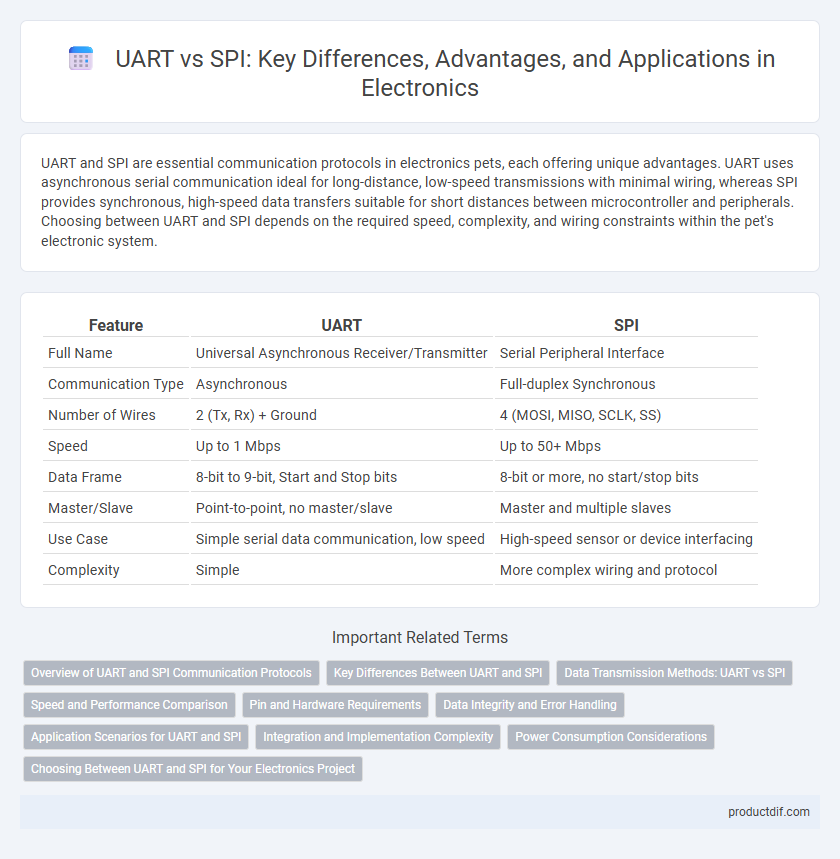UART and SPI are essential communication protocols in electronics pets, each offering unique advantages. UART uses asynchronous serial communication ideal for long-distance, low-speed transmissions with minimal wiring, whereas SPI provides synchronous, high-speed data transfers suitable for short distances between microcontroller and peripherals. Choosing between UART and SPI depends on the required speed, complexity, and wiring constraints within the pet's electronic system.
Table of Comparison
| Feature | UART | SPI |
|---|---|---|
| Full Name | Universal Asynchronous Receiver/Transmitter | Serial Peripheral Interface |
| Communication Type | Asynchronous | Full-duplex Synchronous |
| Number of Wires | 2 (Tx, Rx) + Ground | 4 (MOSI, MISO, SCLK, SS) |
| Speed | Up to 1 Mbps | Up to 50+ Mbps |
| Data Frame | 8-bit to 9-bit, Start and Stop bits | 8-bit or more, no start/stop bits |
| Master/Slave | Point-to-point, no master/slave | Master and multiple slaves |
| Use Case | Simple serial data communication, low speed | High-speed sensor or device interfacing |
| Complexity | Simple | More complex wiring and protocol |
Overview of UART and SPI Communication Protocols
UART (Universal Asynchronous Receiver/Transmitter) is a serial communication protocol that transmits data asynchronously using two wires: TX and RX, with configurable baud rates for flexible speed settings. SPI (Serial Peripheral Interface) operates synchronously, using four wires: MOSI, MISO, SCLK, and SS, enabling high-speed full-duplex data exchange between a master and multiple slaves. UART is commonly used for simple, low-speed communication, while SPI offers faster data rates and precise timing control for complex peripherals.
Key Differences Between UART and SPI
UART (Universal Asynchronous Receiver/Transmitter) uses asynchronous serial communication with start and stop bits, enabling simple point-to-point data exchange, while SPI (Serial Peripheral Interface) is a synchronous protocol employing clock signals for full-duplex data transfer between multiple devices. UART supports lower data rates typically up to 1 Mbps and requires only two wires, whereas SPI supports higher speeds beyond 10 Mbps with multiple lines including MOSI, MISO, SCLK, and CS for device selection. Error detection in UART relies on parity bits, but SPI lacks built-in error checking, making hardware complexity and speed the primary differentiators in embedded system communication design.
Data Transmission Methods: UART vs SPI
UART uses asynchronous serial communication with start and stop bits for framing data, making it suitable for low-speed, point-to-point links. SPI employs synchronous communication using separate clock, data in, and data out lines, enabling faster, full-duplex data transmission across multiple devices. Data transfer rates in SPI typically exceed those of UART due to its clock-driven signaling and parallel data lines.
Speed and Performance Comparison
SPI offers significantly higher data transfer speeds than UART, often reaching up to tens of Mbps compared to UART's typical rates of 115.2 Kbps to 1 Mbps. SPI enables full-duplex communication with multiple devices using separate clock and data lines, enhancing performance in complex applications. UART, while simpler and requiring fewer pins, is generally slower and better suited for low-speed, point-to-point communication.
Pin and Hardware Requirements
UART requires only two pins--transmit (TX) and receive (RX)--making it simpler for basic serial communication, while SPI demands at least four pins: MOSI, MISO, SCLK, and SS for full-duplex data transfer. SPI requires more complex hardware support, such as a master-slave architecture with individual slave select lines, leading to increased pin count and circuit complexity. UART hardware is often integrated into microcontrollers with minimal external components, whereas SPI may need additional hardware for managing multiple devices and clock synchronization.
Data Integrity and Error Handling
UART uses start, stop, and parity bits to ensure data integrity, allowing basic error detection but limited error correction. SPI offers higher data integrity through full-duplex communication and clock synchronization, minimizing timing errors and enabling faster error detection. In critical applications requiring robust error handling, SPI's hardware-based control often outperforms UART's simpler protocol.
Application Scenarios for UART and SPI
UART is ideal for low-speed, long-distance communication between microcontrollers and peripheral devices, making it suitable for applications like GPS modules and Bluetooth transceivers. SPI excels in high-speed data transfer within short distances, commonly used for memory devices, sensors, and display controllers. Embedded systems requiring rapid data exchange and synchronized communication benefit from SPI's full-duplex protocol, while UART's simplicity supports asynchronous serial communication in simpler or resource-constrained applications.
Integration and Implementation Complexity
UART interfaces require fewer pins and simpler wiring compared to SPI, facilitating easy integration into compact electronic systems. SPI involves multiple lines for data, clock, and chip select signals, increasing the complexity of PCB design and firmware control. Microcontrollers with built-in SPI hardware modules often simplify the implementation, but require careful management of the bus to handle multiple devices and prevent signal conflicts.
Power Consumption Considerations
UART typically consumes less power than SPI due to its simpler hardware design and lower data transmission frequency, making it ideal for low-power applications. SPI requires multiple signal lines--MISO, MOSI, SCLK, and SS--that increase power draw, especially at higher clock speeds. For battery-powered or energy-sensitive devices, UART's minimal wiring and asynchronous communication contribute to reduced overall power consumption.
Choosing Between UART and SPI for Your Electronics Project
UART and SPI are both popular serial communication protocols used in electronics projects, with UART offering simple, point-to-point communication ideal for low-speed applications. SPI provides higher data transfer rates and supports multiple devices on the same bus, making it suitable for complex, high-speed data exchanges. When choosing between UART and SPI, consider factors such as required communication speed, device complexity, pin availability, and power consumption to ensure optimal performance for your project.
UART vs SPI Infographic

 productdif.com
productdif.com